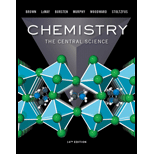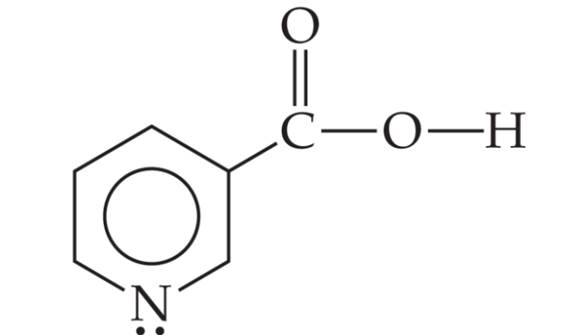
Laboratory Experiments for Chemistry: The Central Science (14th Edition)
14th Edition
ISBN: 9780134566207
Author: Theodore E. Brown, H. Eugene LeMay, Bruce E. Bursten, Catherine Murphy, Patrick Woodward, Matthew E. Stoltzfus, John H. Nelson, Kenneth C. Kemp
Publisher: PEARSON
expand_more
expand_more
format_list_bulleted
Concept explainers
Textbook Question
Chapter 16.6, Problem 16.10.2PE
Practice Exercise 2
Niacin, one of the B vitamins, has the molecular structure shown at the right. A 0.020 M solution of niacin has a pH of 3.26. What is the acid dissociation constant for niacin?

Expert Solution & Answer
Want to see the full answer?
Check out a sample textbook solution
Students have asked these similar questions
tion will be acidic.
Simila
Practice Exercise Predict whether the following solutions will be acidic, basic, or
nearly neutral: (a) LiClO,, (b) Na,PO4, (c) Bi(NO3)3, (d) NH,CN.
Finally we note that some anions can act either as an acid or as a base. For
example, the bicarbonate ion (HCO;) can ionize or undergo hydrolvsis nn foll
need help chemistry problem
need answer
Chapter 16 Solutions
Laboratory Experiments for Chemistry: The Central Science (14th Edition)
Ch. 16.2 - Practice Exercise 1 Consider the following...Ch. 16.2 - Prob. 16.1.2PECh. 16.2 - Prob. 16.2.1PECh. 16.2 - Practice Exercise 2 When lithium oxide (Li2O) is...Ch. 16.2 - Based on information in Figure 16.4, place the...Ch. 16.2 - Practice Exercise 2 For each reaction, use Figure...Ch. 16.3 - Practice Exercise 1 In a certain acidic solution...Ch. 16.3 - Practice Exercise 2 Indicate whether solutions...Ch. 16.3 - Prob. 16.5.1PECh. 16.3 - Prob. 16.5.2PE
Ch. 16.4 - Practice Exercise 1 A solution at 250C has [OH-] =...Ch. 16.4 - Practice Exercise 2 In a sample of lemon juice,...Ch. 16.4 - Practice Exercise 1 A solution at 25° C has pOH =...Ch. 16.4 - Prob. 16.7.2PECh. 16.5 - Practice Exercise 1 Order the following three...Ch. 16.5 - Prob. 16.8.2PECh. 16.5 - Practice Exercise 1 Order the following three...Ch. 16.5 - Prob. 16.9.2PECh. 16.6 - Prob. 16.10.1PECh. 16.6 - Practice Exercise 2 Niacin, one of the B vitamins,...Ch. 16.6 - Prob. 16.11.1PECh. 16.6 - Practice Exercise 2 A 0.020 M solution of niacin...Ch. 16.6 - Practice Exercise 1 What is the pH of a 0.40 M...Ch. 16.6 - Practice Exercise 2 The Ka for niacin (Sample...Ch. 16.6 - Prob. 16.13.1PECh. 16.6 - Prob. 16.13.2PECh. 16.6 - Practice Exercise 1 What is the pH of a 0.28 M...Ch. 16.6 - Practice Exercise 2 Calculate the pH of a 0.020 M...Ch. 16.7 - Prob. 16.15.1PECh. 16.7 - Practice Exercise 2 Which of the following...Ch. 16.7 - Prob. 16.16.1PECh. 16.7 - Practice Exercise 2 What is the morality of an...Ch. 16.8 - Practice Exercise 1 By using information from...Ch. 16.8 - Practice Exercise 2 Based on information in...Ch. 16.9 - Prob. 16.18.1PECh. 16.9 - Prob. 16.18.2PECh. 16.9 - Practice Exercise 1 How many of the following...Ch. 16.9 - Practice Exercise 2 Predict whether the...Ch. 16.10 - Prob. 16.20.1PECh. 16.10 - In each pair, choose the compound that gives the...Ch. 16 - Prob. 1DECh. 16 - a. Identify the Br ted-Lowry acid and base in the...Ch. 16 - Prob. 2ECh. 16 - Prob. 3ECh. 16 - Prob. 4ECh. 16 - 16.5 The following diagrams represent aqueous...Ch. 16 - Prob. 6ECh. 16 - Which of these statements about how the percent...Ch. 16 - 16.8 Each of the three molecules shown here...Ch. 16 - Prob. 9ECh. 16 - Which of the following diagrams best represent an...Ch. 16 - Prob. 11ECh. 16 - Prob. 12ECh. 16 - Prob. 13ECh. 16 - 16.14 Which of the following statements is...Ch. 16 - Prob. 15ECh. 16 - Prob. 16ECh. 16 - Identify the Bronsted-Lowry acid and the...Ch. 16 - Prob. 18ECh. 16 - Prob. 19ECh. 16 - Prob. 20ECh. 16 - Prob. 21ECh. 16 - Prob. 22ECh. 16 - Prob. 23ECh. 16 - Prob. 24ECh. 16 - Prob. 25ECh. 16 - Prob. 26ECh. 16 - Prob. 27ECh. 16 - Prob. 28ECh. 16 - 16.29 Calcualte [H +] for each of the following...Ch. 16 - Prob. 30ECh. 16 - 16.31 At the freezing point of water (0 o C), K10...Ch. 16 - Prob. 32ECh. 16 - Prob. 33ECh. 16 - Prob. 34ECh. 16 - 16.35 Complete the following table by calculating...Ch. 16 - Prob. 36ECh. 16 - Prob. 37ECh. 16 - 16.38 Carbon dioxide in the atmosphere dissolves...Ch. 16 - Prob. 39ECh. 16 - Prob. 40ECh. 16 - Prob. 41ECh. 16 - Prob. 42ECh. 16 - Prob. 43ECh. 16 - Prob. 44ECh. 16 - Prob. 45ECh. 16 - Prob. 46ECh. 16 - Prob. 47ECh. 16 - Prob. 48ECh. 16 - Prob. 49ECh. 16 - write the chemical equation and the Ka expression...Ch. 16 - Prob. 51ECh. 16 - Prob. 52ECh. 16 - Prob. 53ECh. 16 - Prob. 54ECh. 16 - Prob. 55ECh. 16 - Prob. 56ECh. 16 - Prob. 57ECh. 16 - Prob. 58ECh. 16 - Calculate the pH of each of the following solution...Ch. 16 - Prob. 60ECh. 16 - Prob. 61ECh. 16 - Prob. 62ECh. 16 - Calculate the percent ionization of hydrazoic acid...Ch. 16 - 16.64 Calculate the percent ionization of...Ch. 16 - Prob. 65ECh. 16 - Prob. 66ECh. 16 - Prob. 67ECh. 16 - 16.68 The hypochlorite ion, CIO- , acts as a weak...Ch. 16 - Prob. 69ECh. 16 - Prob. 70ECh. 16 - Calculate the molar concentration of OH- in a...Ch. 16 - 16.72 Calculate the molar concentration of OH- in...Ch. 16 - Prob. 73ECh. 16 - Prob. 74ECh. 16 - Prob. 75ECh. 16 - Prob. 76ECh. 16 - a. Given that Ka for acetic acid is 1.8 10-5 and...Ch. 16 - 16.78
a. Given that Kb for ammonia is 1.8 X 10 -5...Ch. 16 - Prob. 79ECh. 16 - Prob. 80ECh. 16 - Prob. 81ECh. 16 - Pyridinium bromide (C5H5NHBr) is a strong...Ch. 16 - Prob. 83ECh. 16 - Prob. 84ECh. 16 - Prob. 85ECh. 16 - 16.86 An unknown salt is either KBr, NH4 C1, KCN,...Ch. 16 - Prob. 87ECh. 16 - Prob. 88ECh. 16 - 16.89 Based on their compositions and structures...Ch. 16 - Prob. 90ECh. 16 - 16.91 Indicate whether each of the following...Ch. 16 - Prob. 92ECh. 16 - Prob. 93ECh. 16 - Prob. 94ECh. 16 - Prob. 95ECh. 16 - Prob. 96ECh. 16 - Prob. 97ECh. 16 - Prob. 98ECh. 16 - Prob. 99AECh. 16 - Prob. 100AECh. 16 - Prob. 101AECh. 16 - Prob. 102AECh. 16 - Prob. 103AECh. 16 - Prob. 104AECh. 16 - Benzoic acid (C6H5COOH) and aniline (C6H5NH2) are...Ch. 16 - Prob. 106AECh. 16 - Prob. 107AECh. 16 - Prob. 108AECh. 16 - Butyric acid is responsible for the foul smell of...Ch. 16 - Prob. 110AECh. 16 - Prob. 111AECh. 16 - Prob. 112AECh. 16 - 1S.113 Many moderately large organic molecules...Ch. 16 - Prob. 114AECh. 16 - Prob. 115AECh. 16 - Prob. 116IECh. 16 - Prob. 117IECh. 16 - Prob. 118IECh. 16 - Prob. 119IECh. 16 - 16.120 At 50 oC, the ion-product constant for H2...Ch. 16 - Prob. 121IECh. 16 - Prob. 122IECh. 16 - Prob. 123IECh. 16 - Prob. 124IECh. 16 - Prob. 125IECh. 16 - Prob. 126IE
Knowledge Booster
Learn more about
Need a deep-dive on the concept behind this application? Look no further. Learn more about this topic, chemistry and related others by exploring similar questions and additional content below.Similar questions
- Practice Exercise Identify the conjugate acid-base pairs for the reaction CN + H20= HCN + OH It is acceptable to represent the proton in aqueour lutiarrow_forwardApple ciders have pH's of approximately 2.9 – 3.3. Are they acidic, basic, or neutral? Answerarrow_forwardPlease correct answer and don't used hand raitingarrow_forward
- Chemistry practice questionarrow_forwardIncorrect Question 16 A volume of 100.0 mL of 0.050 M NH3 is titrated against a 0.100 M HCI solution added to it from a buret. Calculate the pH values of the solution (a) after 0.0 mL of HCI solution have been added, (b) after 10.0 mL of HCI solution have been added, (c) after 25.0 mL of HCI solution have been added, (d) after 50.0 mL of HCI solution have been added, (e) after 60.0 mL of HCI solution have been added. The K, value of ammonia is 1.76x10-5. The answer for (b) is. (answer format: ?.??) 0.0364arrow_forwardPlease correct answer and don't use hand ratingarrow_forward
- Calculate the pH of a solution of 0.34 M HF solution. The Ka for HF is 7.2 x 10-4. pH Submit Questionarrow_forwardAnswer F onlyarrow_forwardQUESTION7 Which solution below has the highest concentration of hydroxide ions? o pH = 7.00 o pH = 12.49 O pH = 7.93 O pH = 10.12 O pH = 3.21 QUESTION 8arrow_forward
arrow_back_ios
SEE MORE QUESTIONS
arrow_forward_ios
Recommended textbooks for you
 ChemistryChemistryISBN:9781305957404Author:Steven S. Zumdahl, Susan A. Zumdahl, Donald J. DeCostePublisher:Cengage Learning
ChemistryChemistryISBN:9781305957404Author:Steven S. Zumdahl, Susan A. Zumdahl, Donald J. DeCostePublisher:Cengage Learning ChemistryChemistryISBN:9781259911156Author:Raymond Chang Dr., Jason Overby ProfessorPublisher:McGraw-Hill Education
ChemistryChemistryISBN:9781259911156Author:Raymond Chang Dr., Jason Overby ProfessorPublisher:McGraw-Hill Education Principles of Instrumental AnalysisChemistryISBN:9781305577213Author:Douglas A. Skoog, F. James Holler, Stanley R. CrouchPublisher:Cengage Learning
Principles of Instrumental AnalysisChemistryISBN:9781305577213Author:Douglas A. Skoog, F. James Holler, Stanley R. CrouchPublisher:Cengage Learning Organic ChemistryChemistryISBN:9780078021558Author:Janice Gorzynski Smith Dr.Publisher:McGraw-Hill Education
Organic ChemistryChemistryISBN:9780078021558Author:Janice Gorzynski Smith Dr.Publisher:McGraw-Hill Education Chemistry: Principles and ReactionsChemistryISBN:9781305079373Author:William L. Masterton, Cecile N. HurleyPublisher:Cengage Learning
Chemistry: Principles and ReactionsChemistryISBN:9781305079373Author:William L. Masterton, Cecile N. HurleyPublisher:Cengage Learning Elementary Principles of Chemical Processes, Bind...ChemistryISBN:9781118431221Author:Richard M. Felder, Ronald W. Rousseau, Lisa G. BullardPublisher:WILEY
Elementary Principles of Chemical Processes, Bind...ChemistryISBN:9781118431221Author:Richard M. Felder, Ronald W. Rousseau, Lisa G. BullardPublisher:WILEY

Chemistry
Chemistry
ISBN:9781305957404
Author:Steven S. Zumdahl, Susan A. Zumdahl, Donald J. DeCoste
Publisher:Cengage Learning

Chemistry
Chemistry
ISBN:9781259911156
Author:Raymond Chang Dr., Jason Overby Professor
Publisher:McGraw-Hill Education

Principles of Instrumental Analysis
Chemistry
ISBN:9781305577213
Author:Douglas A. Skoog, F. James Holler, Stanley R. Crouch
Publisher:Cengage Learning

Organic Chemistry
Chemistry
ISBN:9780078021558
Author:Janice Gorzynski Smith Dr.
Publisher:McGraw-Hill Education

Chemistry: Principles and Reactions
Chemistry
ISBN:9781305079373
Author:William L. Masterton, Cecile N. Hurley
Publisher:Cengage Learning

Elementary Principles of Chemical Processes, Bind...
Chemistry
ISBN:9781118431221
Author:Richard M. Felder, Ronald W. Rousseau, Lisa G. Bullard
Publisher:WILEY
General Chemistry | Acids & Bases; Author: Ninja Nerd;https://www.youtube.com/watch?v=AOr_5tbgfQ0;License: Standard YouTube License, CC-BY